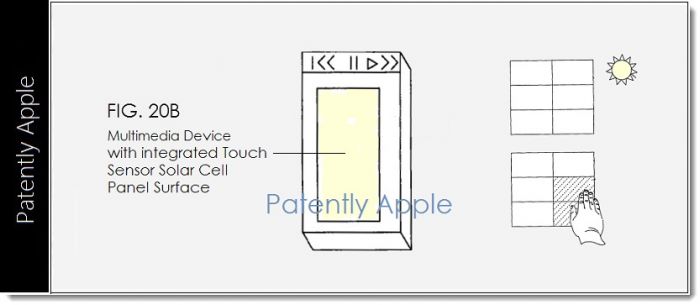Apple surprises with new solar/touchscreen patent
 In what was called a 'shocker' by Patently Apple, a blog—not surprisingly—dedicated to Apple's patents, Apple was granted a patent for a touchscreen that would also serve as a transparent solar charger. Apple filed the patent in 2008. While it's far from the first solar patent by Apple or other tech giants, it could be the last nail in the head to help Apple move forward with making a solar-plowed iPhone or even an iPad.
In what was called a 'shocker' by Patently Apple, a blog—not surprisingly—dedicated to Apple's patents, Apple was granted a patent for a touchscreen that would also serve as a transparent solar charger. Apple filed the patent in 2008. While it's far from the first solar patent by Apple or other tech giants, it could be the last nail in the head to help Apple move forward with making a solar-plowed iPhone or even an iPad.
What’s interesting about this patent is that the solar panel would also operate as the touchscreen itself, rather than as two separate units, observed Forbes. Most touchscreens today use either a resistive (pressure-sensor) or a capacitive (conductive-sensor) screen to respond to touch input. The iPhone and iPad use capacitive touchscreens, for instance. However, the new patent takes a fundamentally different approach.
“The integrated touch sensor array and solar cell stack-ups may include electrodes that are used both for collecting solar energy and for sensing on a touch sensor array,” according to Apple’s abstract. “By integrating both the touch sensors and the solar cell layers into the same stack-up, surface area on the portable device may be conserved. In addition to being used for capacitive sensing, the integrated touch sensor and solar panel configurations may also be used for optical sensing.”
The grant of the new patent was just one of 40 patents granted the company on Feb. 5, according to Patently Apple. However, the new solar/touchscreen grant was somewhat unexpected. “In this particular report we cover a real little shocker,” wrote Patently Apple site manager Jack Purcher. “In this granted patent Apple reveals that they've been working on display panel technology that integrates both touch and solar cells on a single panel since a little after launching their revolutionary iPhone.”
“In the negative hoopla surrounding Apple these days, it is a common lament that Apple is no longer innovating,” wrote Nigam Arora, a Forbes contributor who writes the Arora Report. He added, “A newly approved patent suggests otherwise.”
This is not the first granted patent for Apple’s solar ambitions. It already received two patents related to an electronic microcontroller that could handle energy inputs from multiple sources. It also filed other patents related to solar.
Other companies are also working on transparent PV devices that can be integrated into smartphones, tablets and other devices. One of the furthest along is likely Wysips (What You See is Photovoltaic Surface), a subsidiary of French company SunPartner SAS, which already produced working prototypes in 2011. And in January 2013, they announced their device reached 90 percent transparency and it would be showcased at the Mobile World Congress in Barcelona in February. Their device, however, uses a thin screen that could fit under a smartphone’s touchscreen apparatus to generate electricity, hence the transparency issue. Which company or option will win the horserace remains to be seen.



